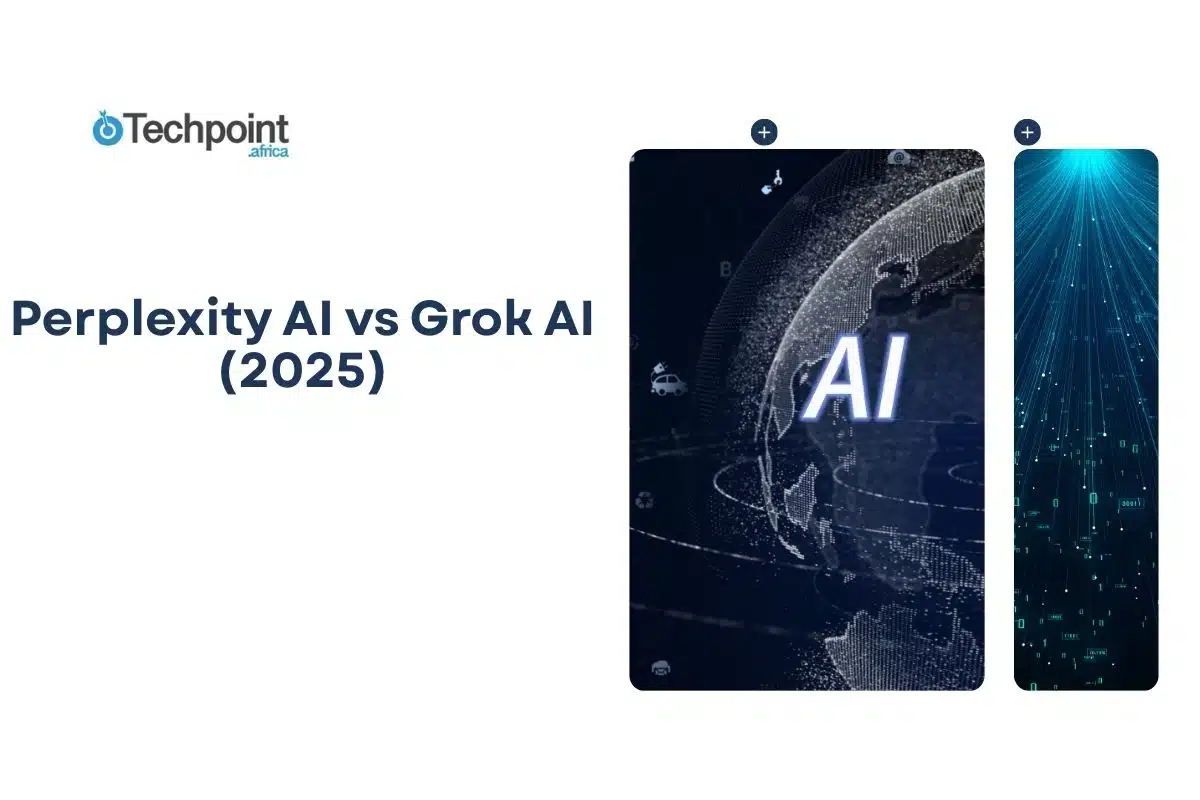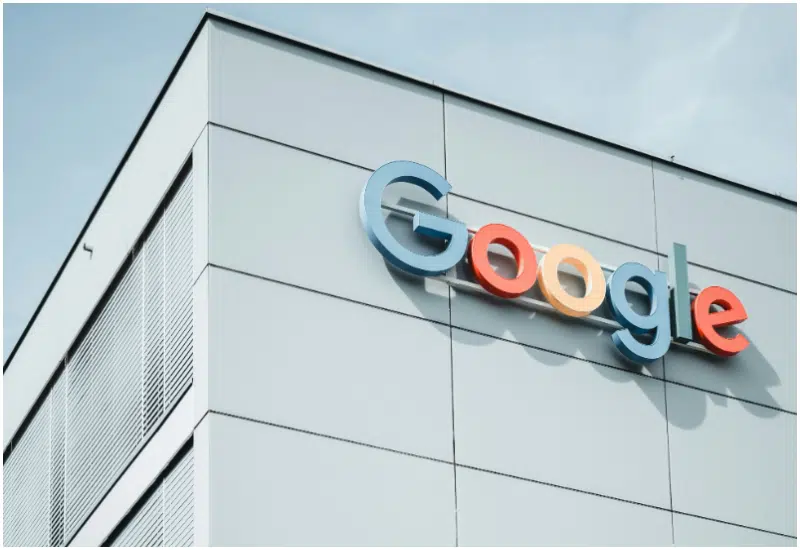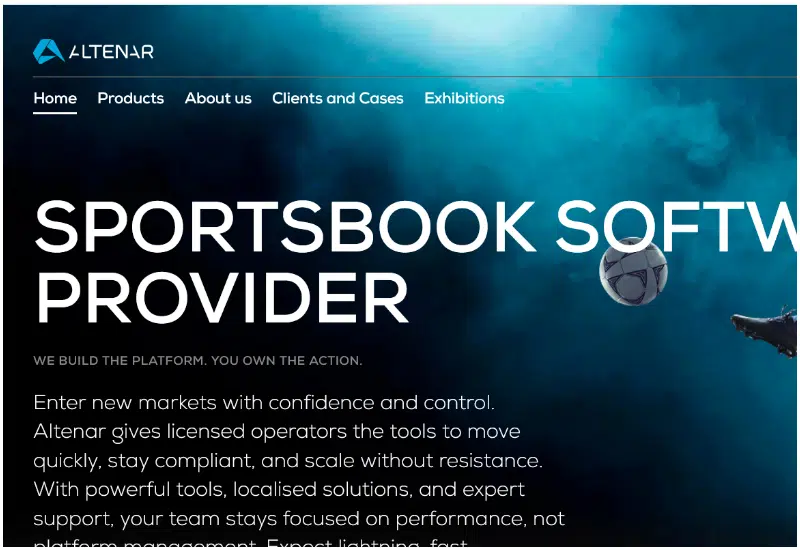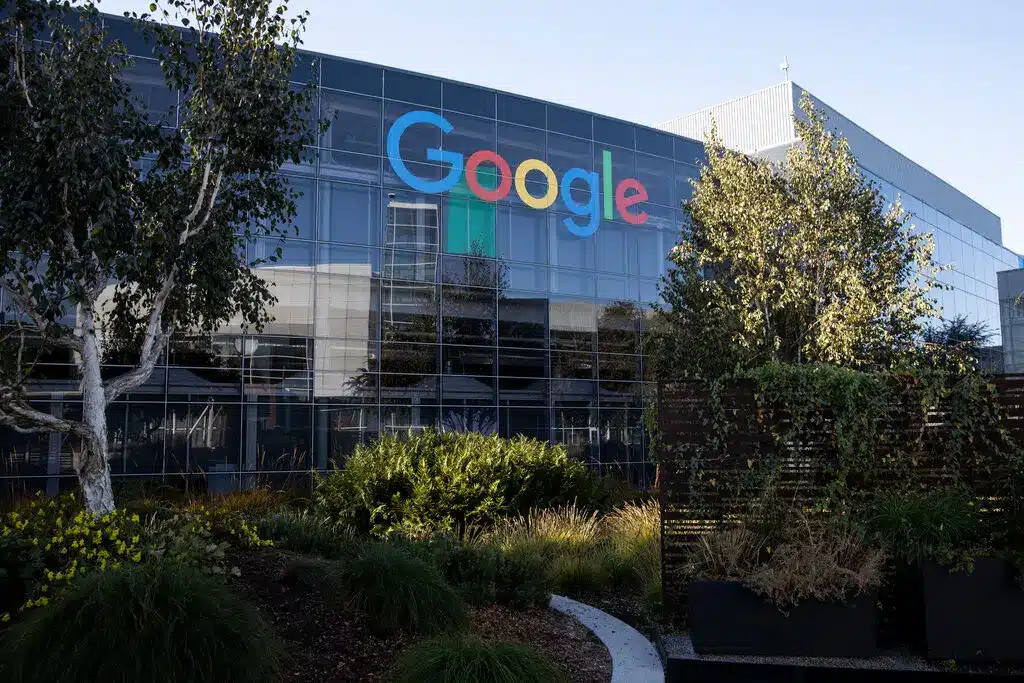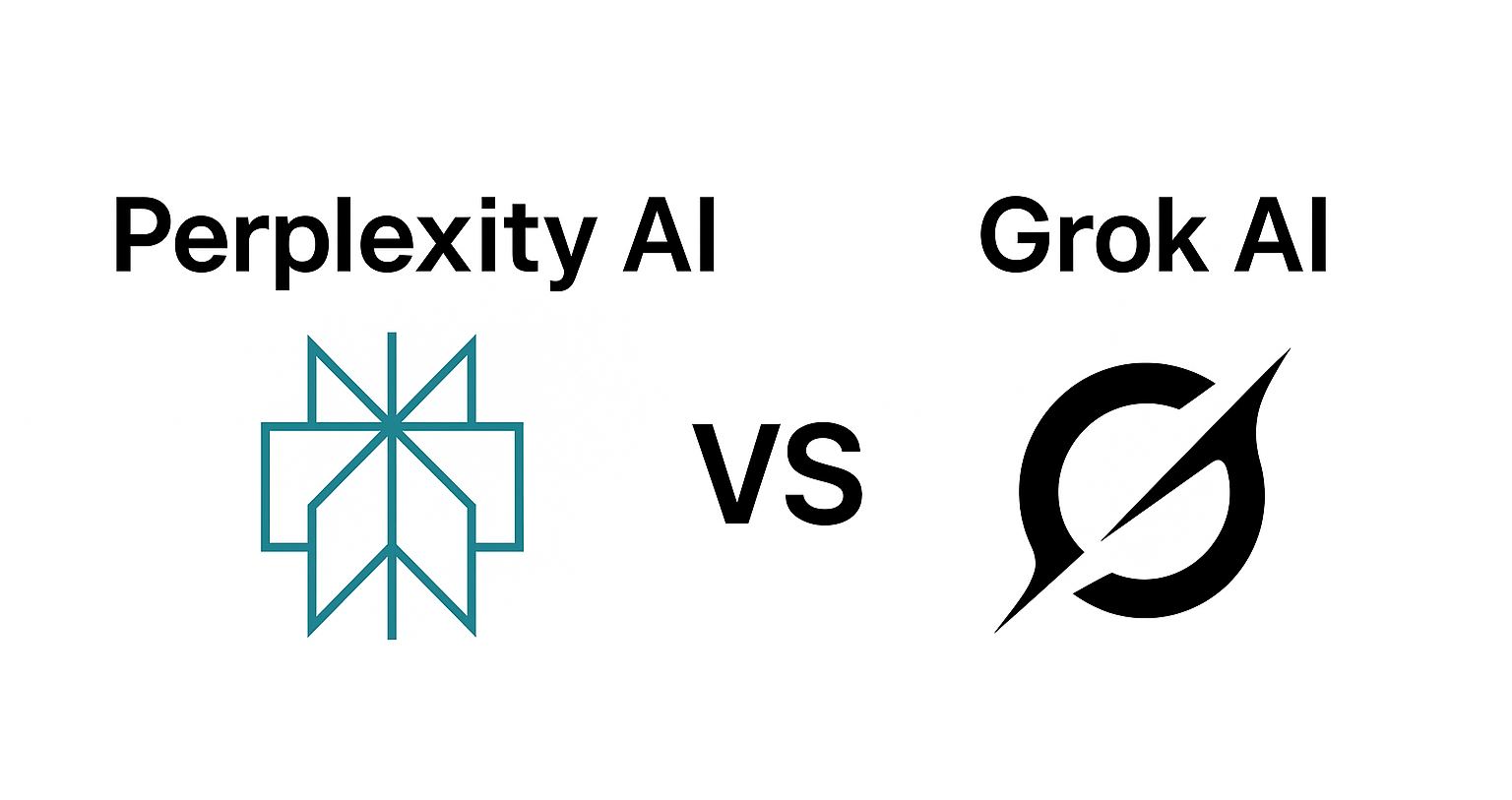
Testing is the key to seeing how AI handles practical, everyday prompts while delivering accurate, clear, and actionable responses. I evaluated Perplexity AI and Grok AI across five distinct use cases, including researching current events, conducting academic-style research, creative writing, solving mathematical problems, and assisting with coding tasks.
I believe these tasks cover what people typically use AI for.
Below, you’ll find a detailed look at everything, along with my work breakdown, as illustrated through the provided screenshots. At the end of reading, you’ll be able to make a valid decision on when to use Perplexity AI and Grok AI.
Key takeaways from Perplexity AI vs Grok AI
- Perplexity AI provides sourced, detailed answers; unlike traditional search engines, it delivers structured responses with inline citations from credible sources, making it suitable for tasks requiring verification and transparency.
- Grok AI emphasizes real-time insights. Integrated with X, it excels at delivering current events and dynamic information quickly, often with a more natural, conversational tone than Perplexity.
- Perplexity AI was created by engineers with extensive experience in AI and research. At the same time, Grok AI’s team includes experts from leading AI labs and Elon Musk, who influences both platform strategy and capabilities.
- Perplexity AI offers autonomous multi-step research reports, whereas Grok AI uses Deep Search and Think Modes to explore multiple perspectives with step-by-step reasoning.
- Both are available on web and mobile, but Grok AI additionally integrates with X and Tesla vehicles, enhancing real-time and in-context accessibility.
- Perplexity AI tends toward structured, factual responses; Grok AI offers conversational, human-like outputs, with personality modes adding stylistic flexibility.
- Perplexity AI offers a generous free tier with unlimited basic searches, 3 Pro queries/day, and up to 10 document uploads/day; paid plans include Pro ($20/month or $200/year), Max ($200/month or $2,000/year), and Enterprise Pro ($40/month per seat or $400/year). Grok AI’s free access is heavily limited with count-based usage; paid plans include SuperGrok ($30/month or $300/year) and SuperGrok Heavy ($300/month or $3,000/year), focusing on advanced reasoning, DeepSearch, and high-demand tasks.
- Perplexity AI excels in accuracy, source diversity, and academic-style synthesis. At the same time, Grok AI is faster and more flexible for creative, coding, and multimedia tasks, but it can rely heavily on X-based sources, limiting diversity.
What’s Perplexity AI?
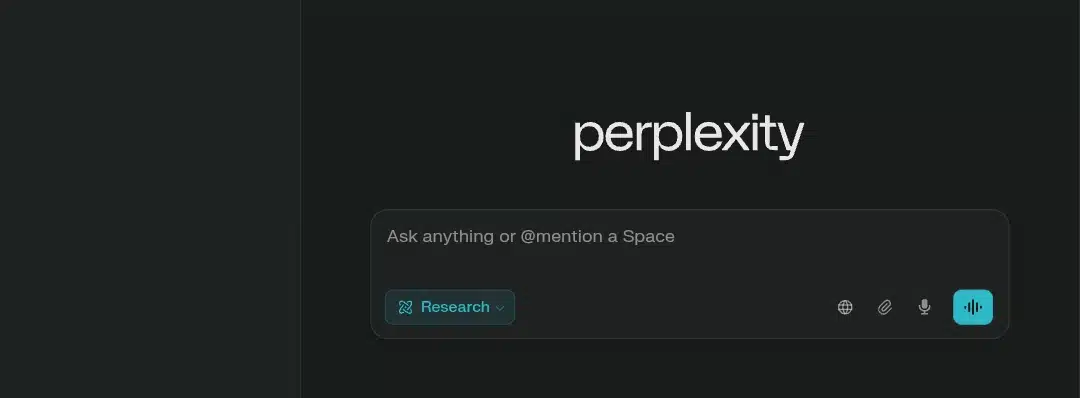
Perplexity AI is a conversational search engine designed to provide direct, well-sourced answers to user queries. Instead of a list of links like traditional search engines, it combines real-time information retrieval, natural language processing, and machine learning to operate as an “answer engine,” delivering detailed responses with full source citations.
The company was founded in August 2022 in San Francisco, California, by four engineers:
- Aravind Srinivas (CEO) – Former AI researcher at OpenAI, DeepMind, and Google Brain.
- Denis Yarats (CTO) – Previously an AI research scientist at Meta.
- Johnny Ho (Chief Strategy Officer) – Former at Quora and quantitative trader at Tower Research Capital.
- Andy Konwinski (President and Board Member) – Co-founder of Databricks, a cloud-based data analytics platform.
Together, they successfully brainstormed and built a system that could retrieve and synthesize information as if an expert were answering directly.
On the business front, Perplexity AI completed multiple funding rounds that propelled it to unicorn status, with a valuation surpassing $1 billion, thanks to investments from high-profile investors, including Jeff Bezos, NVIDIA, Daniel Gross, and Stan Druckenmiller. By November 2024, a final capital raise brought the company’s estimated valuation to $9 billion, a significantly high sum that has marked its place in AI.
Also, Perplexity AI is accessible across major platforms, not only through the web but also via the official app on both Google Play and the Apple App Store, so it’s available on Android, iPhone, and iPad. This cross-platform support ensures you can take advantage of the conversational search experience wherever you go.
But what unique toolset does Perplexity AI have?
Perplexity AI’s features
Here are the most available features you’ll find as you sign in and begin using Perplexity AI:
Deep Research (autonomous, multi-step reports)
For larger questions, Deep Research executes dozens of searches, reads hundreds of sources, and synthesizes a structured report on its own. It’s designed for expert-level tasks (market scans, product research, finance/marketing analysis) and aims to save hours by handling the end-to-end search-plan–read–summarize circle.
Pro model selection (advanced reasoning options)
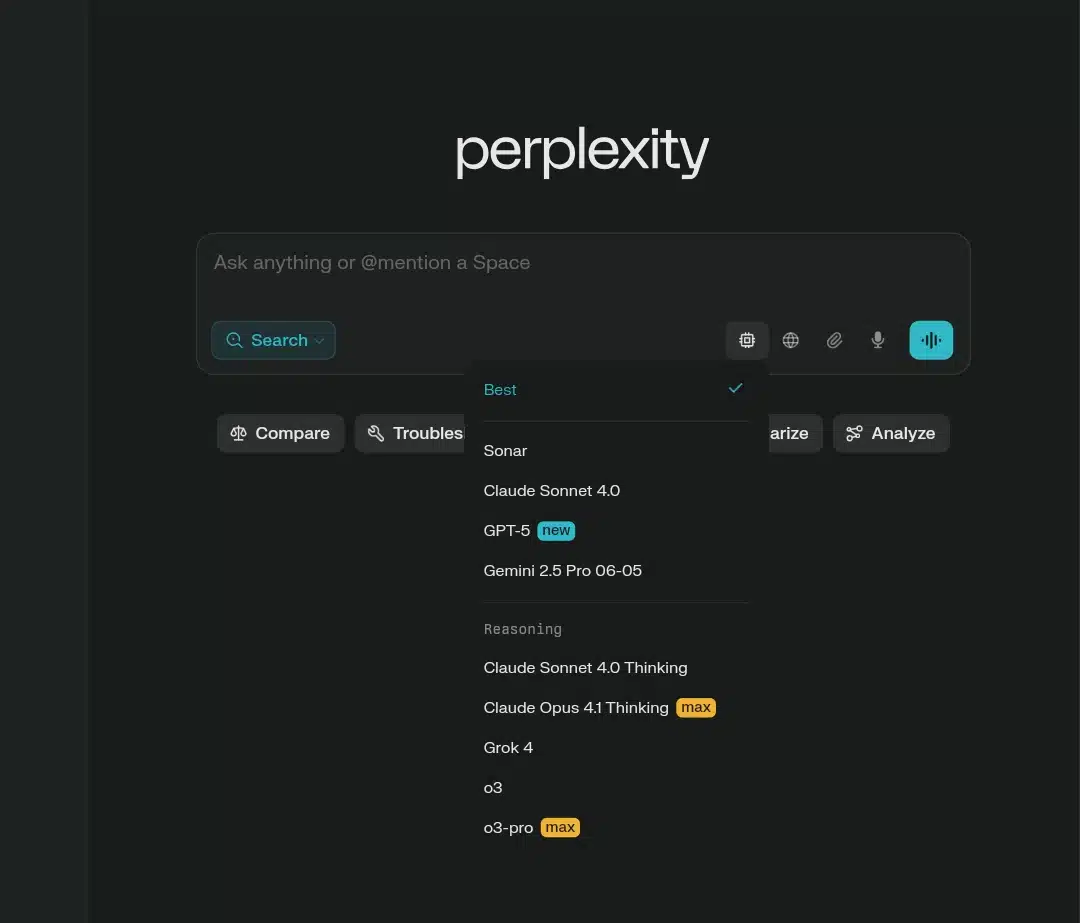
With Perplexity Pro, you can choose from advanced models when you need depth over speed. Current options listed in Perplexity’s help center include GPT-5, Claude 4.0 Sonnet, and Gemini 2.5 Pro (alongside Perplexity’s in-house Sonar), which you can switch between based on the task. This makes it easy to trade off raw reasoning strength, style, and latency as needed.
Source control and “Choose Sources”
Beyond generic web search, Perplexity lets you constrain or prioritize sources. Using Custom Web Sources and the Choose Sources control, you can search only specific sites, the open web, your organization’s files, or a combination—proper for compliance and reproducibility. Enterprise users can toggle Web, Org Files, Web + Org Files, or None to force answers from the desired corpus.
Image generation (create and edit)
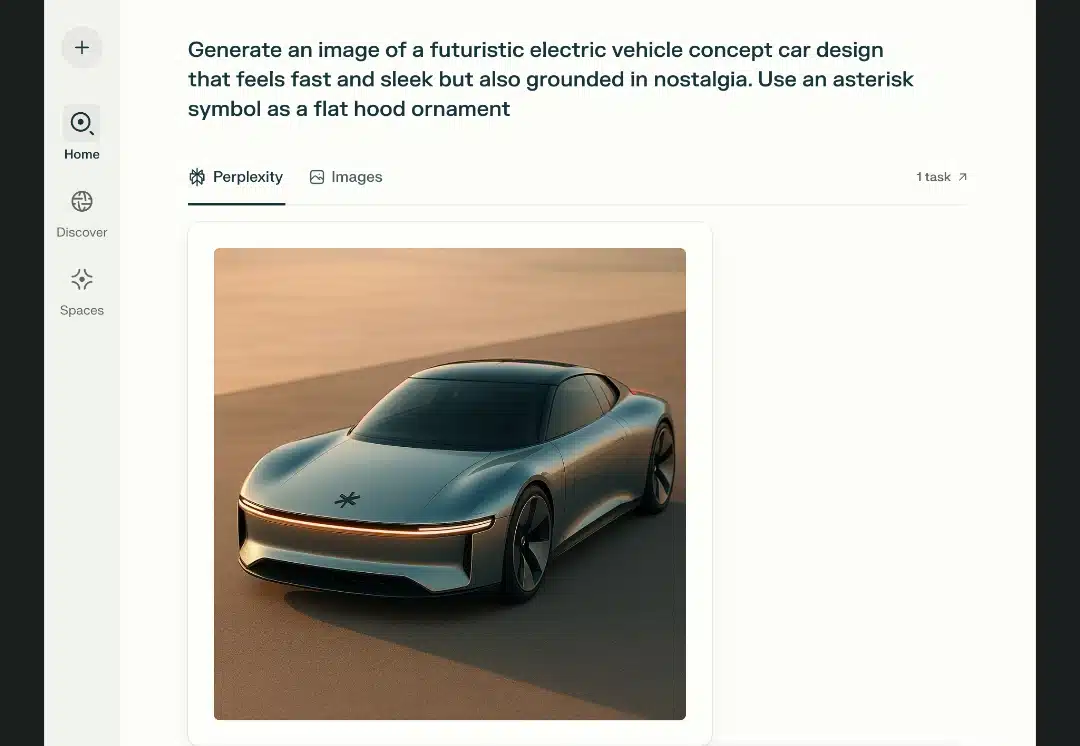
Perplexity now supports generating and editing images directly from prompts. The Help Center describes this as a native feature; typical usage is asking for an image in the same chat you’re researching and iterating with edits. (Free users get limited generation; Pro expands access.)
Perplexity Pages (turn research into shareable content)
With Pages, you can transform a research thread into a polished, visually structured article or guide, preserving sources section-by-section. It’s handy for slide-ready briefs, docs for stakeholders, and public explainers you want to share.
Organization: threads, Spaces/Collections, sharing

Research is stored as threads that you can title and organize. Guides note the ability to group related work in Spaces/Collections, which helps when you’re building a body of research across multiple prompts and want consistent instructions or scope. Threads and Pages are shareable for collaboration.
Academic and topical focusing
Perplexity supports academic-oriented search to prioritize scholarly sources. In the product and API, the Academic mode/filter steers results toward peer-reviewed literature and reputable journals, which are helpful for citations and literature reviews. (On some plans, “Focus” on the web has evolved into “Choose Sources,” while the academic emphasis remains available.)
Finance features (market data workflows)
Perplexity offers a Finance experience that centers on research around tickers, earnings, and market updates. Recent demos highlight capabilities such as Earnings Hubs, price alerts, and automated “tasks” that assemble watchlist-style summaries, positioning Perplexity as a light research terminal for news-plus-numbers queries.
Buy with Pro & Snap to Shop

Perplexity’s shopping-focused tools extend the platform beyond research into practical e-commerce. Buy with Pro allows U.S.-based Pro subscribers to purchase eligible products directly within Perplexity, using saved billing and shipping details for a one-click checkout experience. The feature also offers free shipping, aiming to make product discovery and purchase seamless.
Complementing it, Snap to Shop brings visual search to the platform. Users can take or upload a photo of an item, and Perplexity will locate similar products online, complete with purchasing options. This works much like Google Lens but is integrated directly into Perplexity’s interface. Together, these tools position Perplexity as an “answer engine” and a personal shopping assistant for Pro users in the U.S.
Note: Perplexity has stated that both tools are planned for international expansion in the future, though no specific rollout timeline has been confirmed.
Always-visible citations and real-time web
A consistent differentiator is the always-visible citations attached to each claim, paired with real-time web retrieval. You can expand the footnotes, jump to sources, and keep asking clarifying or comparative follow-ups without losing the link to where facts came from. This transparency is central to Perplexity’s “answer engine” approach.
So, Perplexity combines an answer-first interface with deep-dive automation (Deep Research), model choice for more challenging problems, controllable source scopes (web, specific sites, or internal files), image generation, Pages for publishing, and finance-oriented views. It also makes verification easy via inline citations tied to live web results.
How to sign up on Perplexity AI
Getting started with Perplexity AI using the web version or mobile app is quick and straightforward.
If you’re signing up on a browser, open your preferred search engine and type “Perplexity AI.” Click on the official link (usually the first result), and you’ll be taken directly to the Perplexity AI interface. On the home screen, you’ll see a sign-in or sign-up box—usually at the right end of the screen. You can choose to create an account using an Apple ID, a Google account, or an email address. Selecting the Google option lets you connect instantly (often without manually typing your email), making the process nearly instant.
For mobile users, simply download the Perplexity AI app from the Google Play Store (for Android) or the Apple App Store (for iOS). Once installed, open the app and follow the same sign-up process.
In either case, once you’ve chosen your sign-in method, you’ll be directed straight into the interface, ready to start searching or asking questions immediately. No lengthy verification steps are required, making Perplexity AI one of the fastest AI tools to access.
Note that you can now ask Perplexity AI questions on X and WhatsApp.
Now, let’s meet Grok AI.
What’s Grok AI?
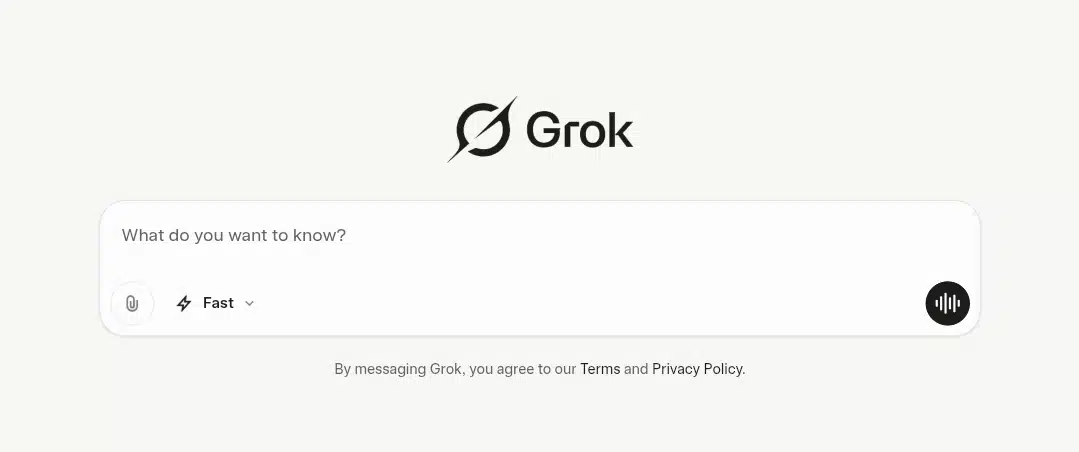
Grok AI is an artificial intelligence chatbot developed by xAI, the AI company founded by Elon Musk. Officially unveiled on November 4, 2023, the platform was designed to deliver an alternative approach to conversational AI while integrating closely with X (formerly Twitter).
Its integration began in July 2023, when xAI was founded with the stated mission of advancing AI in ways that are maximally beneficial to humanity. While operating independently, the company works closely with Musk’s other ventures, particularly X, to take advantage of real-time information and large-scale user engagement.
The founding team includes experienced engineers and researchers from leading AI organizations such as OpenAI, DeepMind, and Google Research. Elon Musk himself serves as the company’s public face and strategic leader. He brings expertise in deep learning, large language models, platform integration, and advanced systems engineering alongside these team members.
Since its launch, Grok AI has seen steady technical progress. Initially released in beta for X Premium+ subscribers, it became available to all Premium subscribers in March 2024. Over the next 18 months, the team introduced Grok-1, Grok-1.5, Grok-2, Grok-3, and Grok-4. These updates expanded the system’s capabilities, from open-sourcing its base model and extending context length to adding multimodal functions like image understanding and generation, making the system run more efficiently.
What can Grok AI do for you?
Grok AI’s capabilities extend far beyond basic chat functions. It combines advanced search, creative tools, technical execution, and adaptive personalities to meet various needs. Here’s a closer look at its standout features:
Deep search & think modes
Grok’s Deep Search goes beyond surface-level results to pull them from current, credible sources. It doesn’t just list links, but organizes findings, draws connections, and presents insights in plain language. Think Modes adds another flex by allowing step-by-step reasoning paths. You can request the AI to “think aloud,” review its intermediate steps, or refine a query mid-process. This makes it great for projects that require accuracy, transparency, and an ability to explore multiple perspectives before forming conclusions.
Image generation & multimedia interaction
Using xAI’s Aurora model, Grok AI transforms text prompts into original visuals, charts, or illustrative graphics. The image generator adapts to different styles and levels of detail. Beyond static visuals, Grok supports multimedia interaction; you can upload images for analysis, annotate them collaboratively, or combine text and visuals for richer outputs. This is especially valuable for creative professionals, marketers, and educators who need visual elements integrated into their workflows.
Code & document creation
From drafting clean, functional code to producing fully formatted documents, Grok is built for both technical and content-driven tasks. Developers can generate, debug, or refactor code in multiple programming languages. On the document side, it supports everything from structured reports and proposals to formatted articles and presentations. Built-in formatting tools reduce manual editing, while its contextual understanding ensures outputs align with the intended audience and purpose.
Personality modes
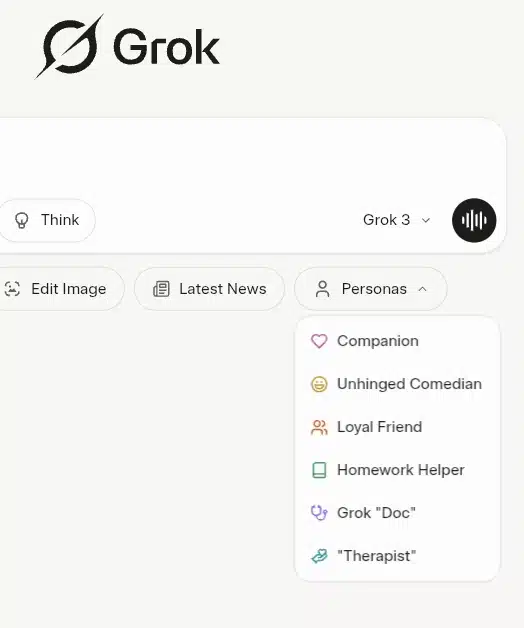
Instead of a one-size-fits-all tone, Grok adapts its style to match your preferred interaction type. Users can switch between different personality profiles, such as Companion for warm and supportive chats, Unhinged Comedian for playful banter, Loyal Friend for casual conversations, Homework Helper for academic support, Doc for professional, advice-focused dialogue, and Therapist for reflective discussions. While the personality changes the communication style, the underlying accuracy and capability remain constant, giving you the same intelligence with a different voice.
Latest news integration
Grok features a live news tracking system that delivers timely updates across various topics, including politics, technology, sports, entertainment, and global events. It doesn’t stop at headlines; the AI analyzes developments, identifies patterns, and connects related stories for context. This enables the tracking of complex, evolving situations without the need for manual scanning of multiple outlets. For professionals and news enthusiasts alike, it functions as both a feed and an analytical companion.
How to access Grok AI and its features
Accessing Grok AI is simple, with multiple entry points designed to be convenient across devices and platforms.
Browser access through the official website
You can use Grok AI directly in a web browser without any extra downloads. Open Chrome, Firefox, Safari, or your preferred browser, then search for “Grok AI” or go straight to the official site. In the top-right corner, you’ll see a Sign-up button. Clicking it opens a quick registration form where you can choose to sign up using your X account, email, Apple ID, or Google account. After selecting your method, follow the verification steps, and within moments, you’ll be signed in and ready to explore Grok’s tools.
Access through X integration
Because Grok is built to work closely with X, you can interact with it directly from your X account. Simply log in at X.com using your existing credentials, or create a new account if you don’t have one. Subscribers to X Premium or Premium+ can utilize Grok’s full range of features directly within the platform, allowing for seamless transitions between social networking and AI-powered assistance without needing to switch apps.
Mobile app downloads
For on-the-go access, Grok is available as a dedicated mobile application. Head to the Google Play Store on Android or the Apple App Store on iOS, search for the official Grok app, and download it. The app is designed for a smooth, touch-friendly experience and includes all the same features as the desktop version, allowing you to work, create, or research wherever you are.
Tesla in-car access
Since July 2025, Grok has also been available inside Tesla vehicles. While it can’t control driving functions, it can assist with research, answer questions, generate ideas, and provide entertainment during your journey without leaving your car’s built-in interface.
What I tested Perplexity AI vs Grok AI on, and how I scored them
Perplexity AI and Grok AI were tested under the same conditions, using the same prompts. I aimed to determine which tool delivers better results for daily use.
I used the following categories for relevant reasons.
| Category | Reason for category |
| Real-time information accuracy | Can they handle current events, breaking news, and recent developments without mixing in outdated information? This tests their ability to distinguish between fresh and stale data. |
| Source reliability and citations | Do they provide sources? Are these sources trustworthy and relevant? Can users easily verify the information by following the provided links? |
| Research capabilities | Can they gather information from multiple sources, synthesize it effectively, and present clear, well-structured answers instead of overwhelming text dumps? |
| Creative tasks | Can they adapt writing style based on specific instructions, avoid generic responses, and produce original content that matches the requested tone and format? |
| Mathematics | Can they solve problems step-by-step, explain their reasoning clearly, and handle both basic calculations and more complex mathematical concepts? |
| Coding assistant | Can they write functional code, debug existing code, explain programming concepts, and provide solutions that actually work? |
| User interface and experience | How smooth is the signup process, query submission, feature navigation, and overall platform usability? Are there any confusing elements or unnecessary friction? |
| Response speed and quality | How quickly do they deliver helpful answers? Is faster always better, or do some tools sacrifice accuracy for speed? |
Each category received a score from 1 to 10:
- 10 standing for excellent performance, exceeds expectations,
- 7-8: standing for solid results with minor issues,
- 5-6 standing for adequate but inconsistent performance,
- 3-4 standing for below average with notable problems; ay
- 1-2 for poor performance, barely functional
Testing Perplexity AI vs Grok AI on real tasks
Here’s what I discovered when I used the same prompts on both systems.
- Real-time information accuracy test
My Prompt: “Summarize the three most significant global news events that occurred in the last 48 hours, including exact dates, main stakeholders, verified sources, and measurable impact (economic, political, or social). Use only credible sources from major news outlets or official government releases, and provide inline citations with links. Keep your answer under 300 words and structured into three short sections (one per event).”
Perplexity AI’s performance:
Perplexity delivered three current events from August 12-13, 2025: the Russia-Ukraine conflict with Trump’s Alaska summit, Canadian wildfires, and Air Canada flight cancellations. The response was impressively fast and well-structured.
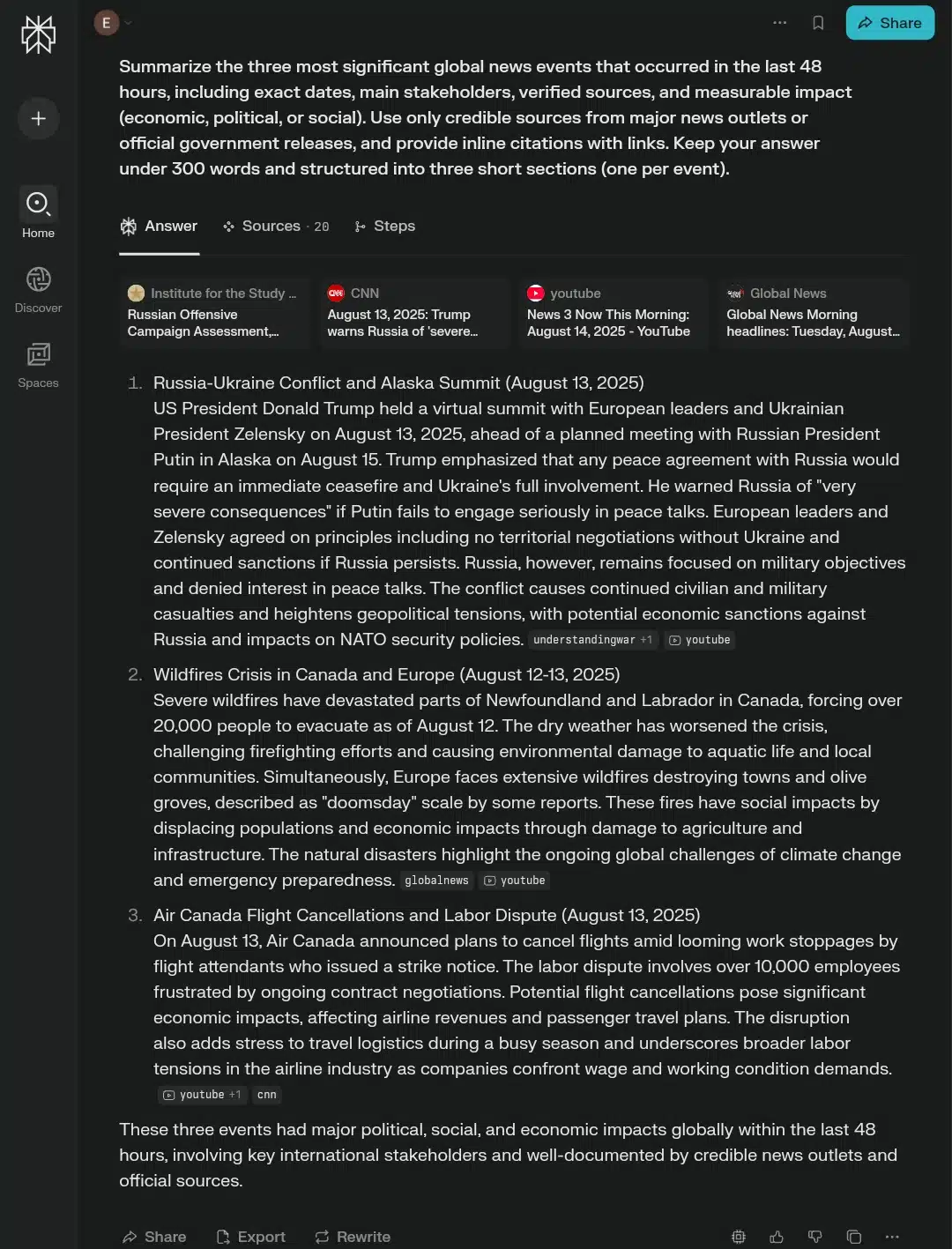
What stood out was the source diversity. I could see citations from CNN, Institute for the Study of War, YouTube, and Global News. Each event included specific dates, stakeholder names (Trump, Zelensky, Putin), and measurable impacts like “over 20,000 people evacuated” and “over 10,000 employees” affected by the labor dispute.
The platform handled the 300-word limit perfectly and organized everything into the three requested sections. The sources were clickable and led to legitimate news outlets. However, I noticed the writing felt somewhat mechanical – factual but lacking natural flow.
Perplexity AI’s score on real-time information accuracy – 9/10
Grok AI’s performance:
Grok provided three current events: Ukraine Diplomacy Escalation (August 13, 2025), Gaza Strikes Intensify (August 13, 2025), and Russia-Belarus Military Drills (August 12-13, 2025). The response was notably fast, completing in just 1 minute 17 seconds.
What impressed me was the detail level. Grok included specific quotes like “… told the U.S. president… that Putin is bluffing” and precise casualty numbers from Gaza. Each event included clear stakeholder identification and measurable impacts like “Over 100 deaths” and “heightened regional tensions.”
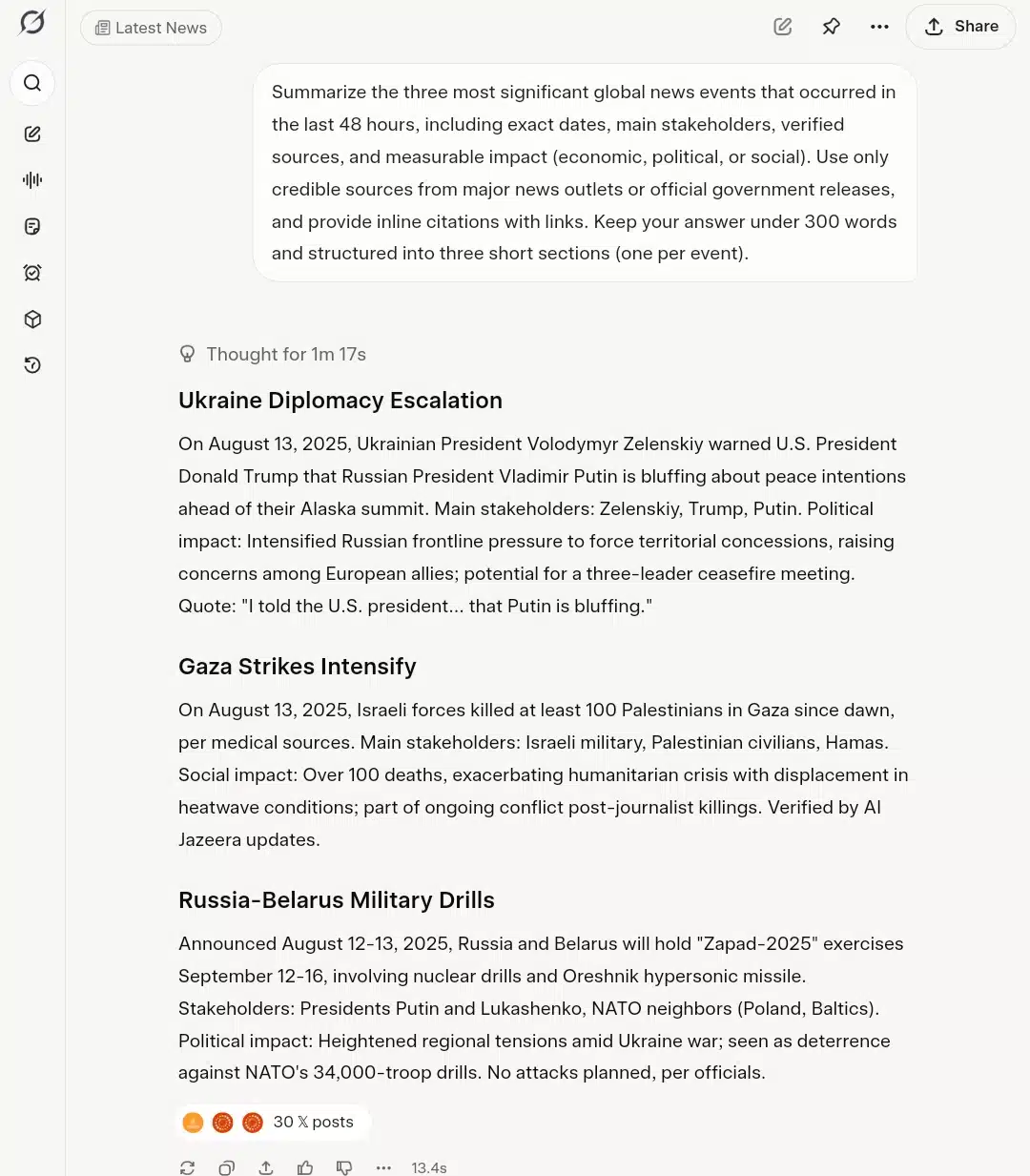
However, I noticed Grok relied heavily on X-post as a source without showing the same source diversity that Perplexity demonstrated. The writing was more natural and conversational compared to Perplexity’s mechanical tone.
Grok AI’s score on real-time information accuracy – 8/10
- Research capabilities test
My Prompt: “Provide a concise but academically rigorous literature review of peer-reviewed studies (published 2018–2025) on the effectiveness of cognitive behavioral therapy (CBT) for treating adolescent depression. Summarize key findings, methodologies, sample sizes, and limitations for at least five studies. Use APA in-text citations and end with a proper APA-style reference list.”
Perplexity AI’s performance:
This is where Perplexity truly impressed me. The platform delivered exactly five studies as requested, all within the specified timeframe. Each study summary included methodologies (randomized controlled trials, systematic reviews), specific sample sizes (57 adolescents, 409 randomized trials), and apparent limitations.
The APA citations were properly formatted throughout, both in-text and in the reference list. Sources came from credible journals like BMC Psychiatry, Psychological Medicine, and Child and Adolescent Psychiatric Clinics. The platform even included proper DOI links and PMCID numbers.

What impressed me most was the synthesis quality. Instead of just listing studies, Perplexity connected findings across research, noting patterns like “medium to large effects on symptom reduction” and highlighting gaps like “limited long-term follow-up data.”
Perplexity AI’s score on research capabilities – 10/10
Grok AI’s performance:
Grok delivered an impressively comprehensive literature review, completing the task in just 3 minutes and 13 seconds. The platform provided exactly five studies as requested, all within the 2018-2025 timeframe, with proper APA formatting throughout.
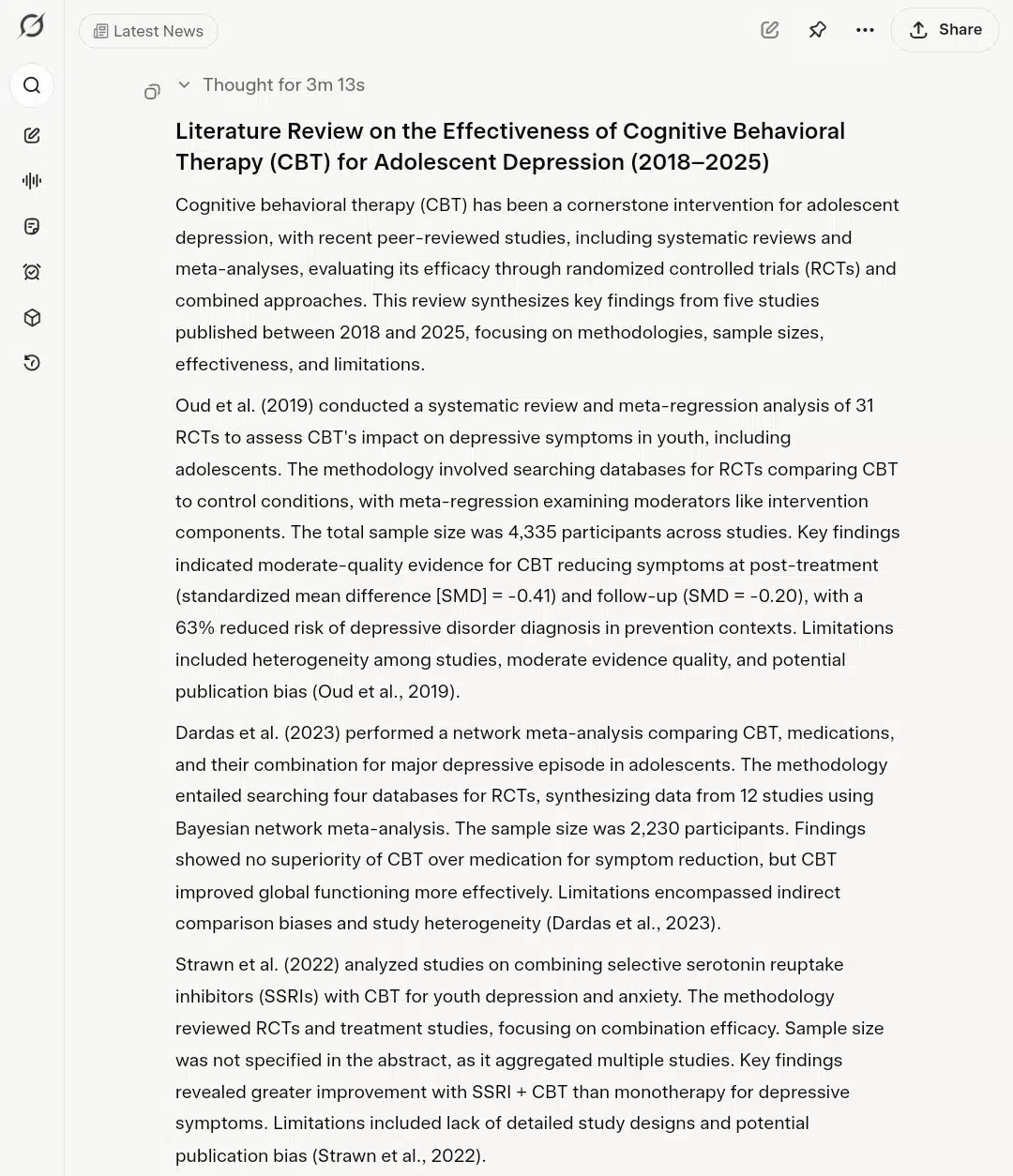
Each study summary included detailed methodologies (meta-regression analysis, network meta-analysis, Bayesian approaches), specific sample sizes (4,335 participants, 2,230 participants), and clear limitations. The DOI links were formatted correctly, and the reference list followed APA standards perfectly.
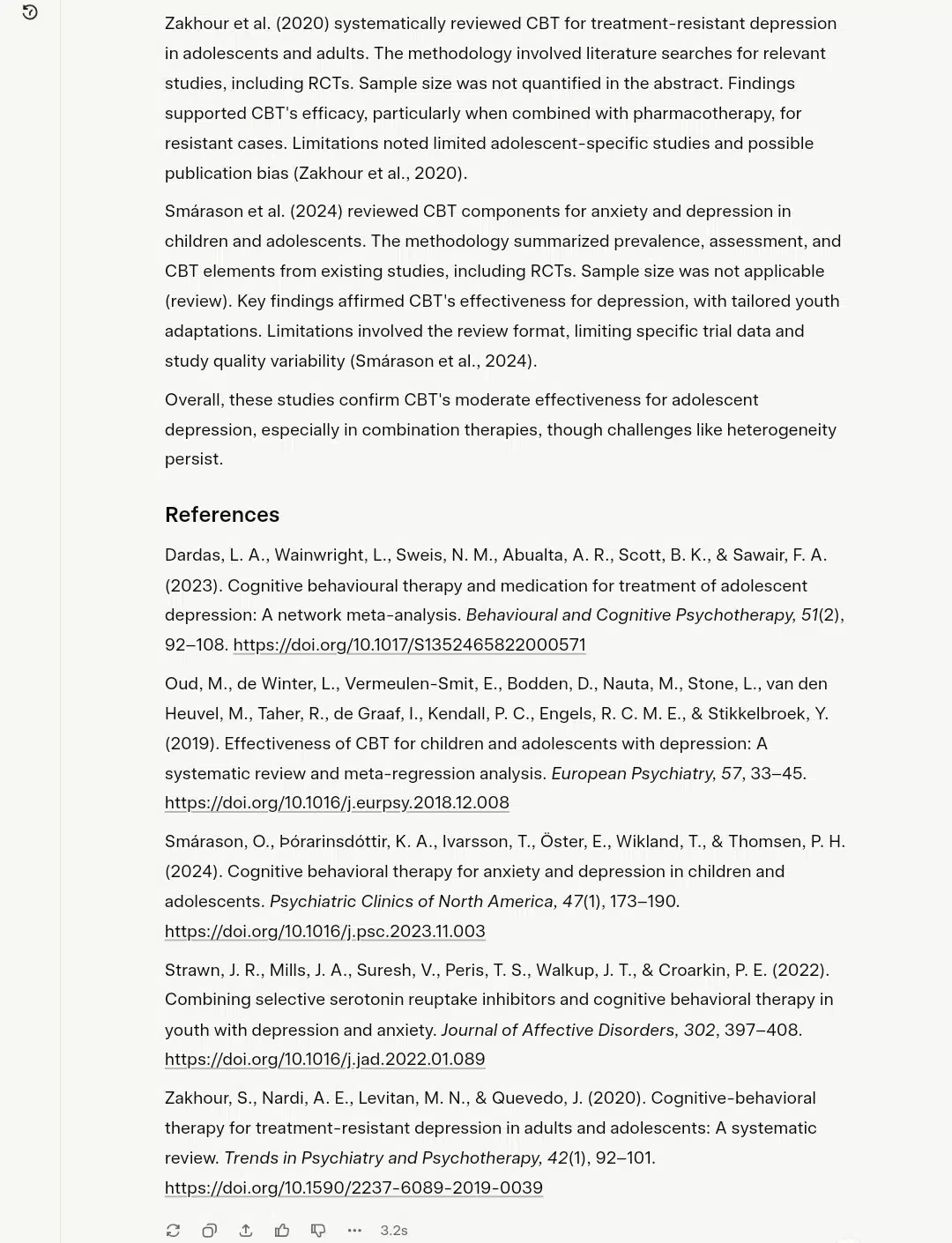
What stood out was Grok’s ability to synthesize findings across studies, noting patterns like “moderate effectiveness for adolescent depression, especially in combination therapies.” The academic rigor matched Perplexity’s quality while maintaining better readability.
Grok AI’s score on research capabilities – 10/10
- Mathematics test
My Prompt: “A company’s revenue grows 12% per year for 5 years, starting from $250,000. Calculate the final revenue using compound growth.”
Perplexity AI’s performance:
The mathematical approach was textbook perfect. Perplexity clearly stated the compound interest formula, identified each variable, and showed every calculation step. The progression from $250,000 × (1.12)^5 to the final answer of $440,575 was easy to follow.
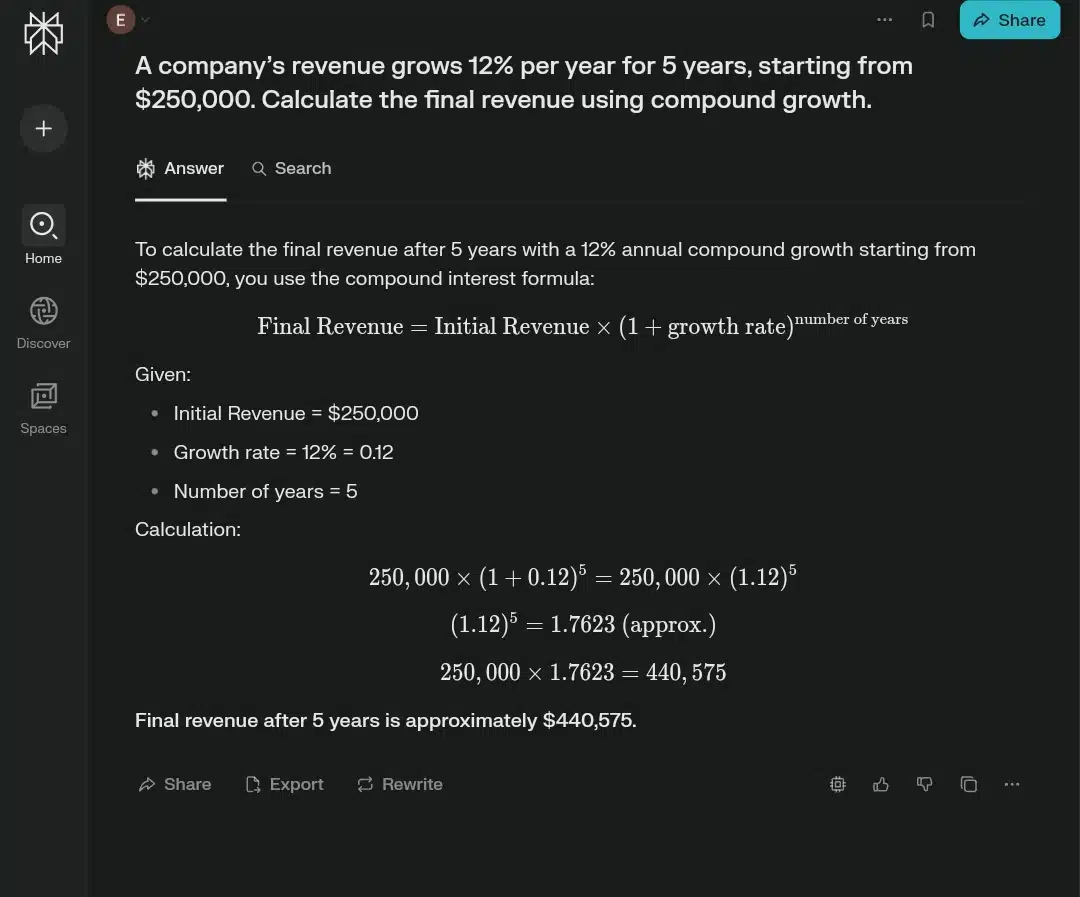
However, the response felt very academic and formal. While mathematically accurate, it lacked the conversational tone that might help someone actually understand compound growth in practical terms.
Perplexity AI’s score on the Mathematics test – 8/10
Grok AI’s performance:
Grok provided a thorough mathematical solution, completing the compound growth calculation in 12 seconds. The platform showed the complete formula, identified each variable clearly, and demonstrated every calculation step from (1.12)¹ through (1.12)⁵.
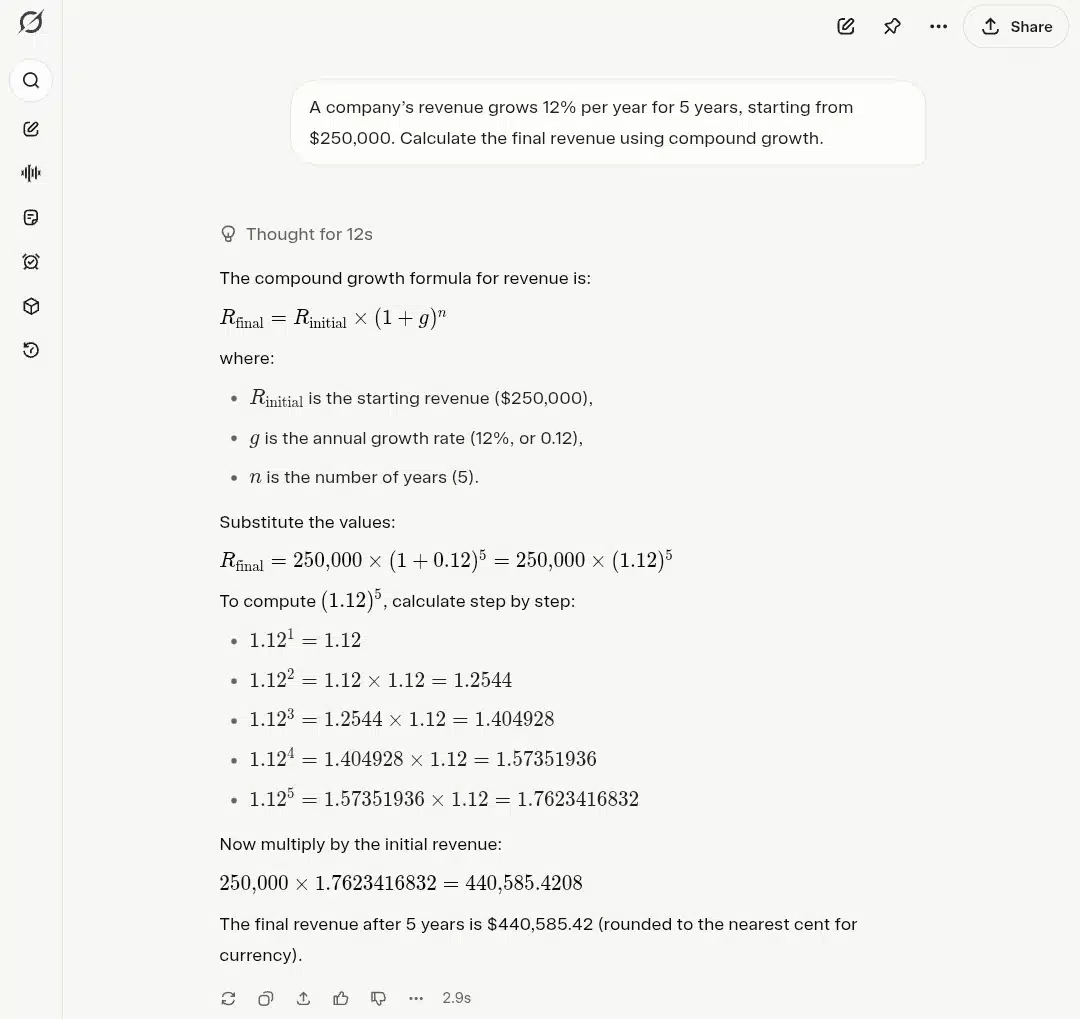
The step-by-step breakdown was excellent for learning: showing each power calculation (1.12² = 1.2544, 1.12³ = 1.404928, etc.) before arriving at the final answer of $440,585.42. The presentation was clear, and the rounding was appropriate for currency.
While mathematically perfect, the approach was very systematic and educational rather than conversational, similar to Perplexity’s academic style.
Grok AI’s score on the Mathematics test – 9/10
- Creative tasks test
My Prompt: “Write a 300-word short script in the style of Ernest Hemingway, set in post-war Paris, following a disillusioned journalist who meets a stranger at a café. Use minimalist prose, subtle dialogue, and vivid sensory details. End with an ambiguous emotional resolution.”
Perplexity AI’s performance:
The creative writing revealed Perplexity’s biggest weakness. While the platform delivered exactly 300 words and captured some Hemingway elements like sparse dialogue and a post-war Paris setting, the writing felt stiff and artificial.
The dialogue followed the minimalist requirement but lacked the subtle emotional undercurrents that make Hemingway’s style compelling. Phrases like “stitched together by ghosts” felt forced rather than naturally poetic. The sensory details were present but mechanical in “soft clatter of spoons,” “rain-streaked windows.”
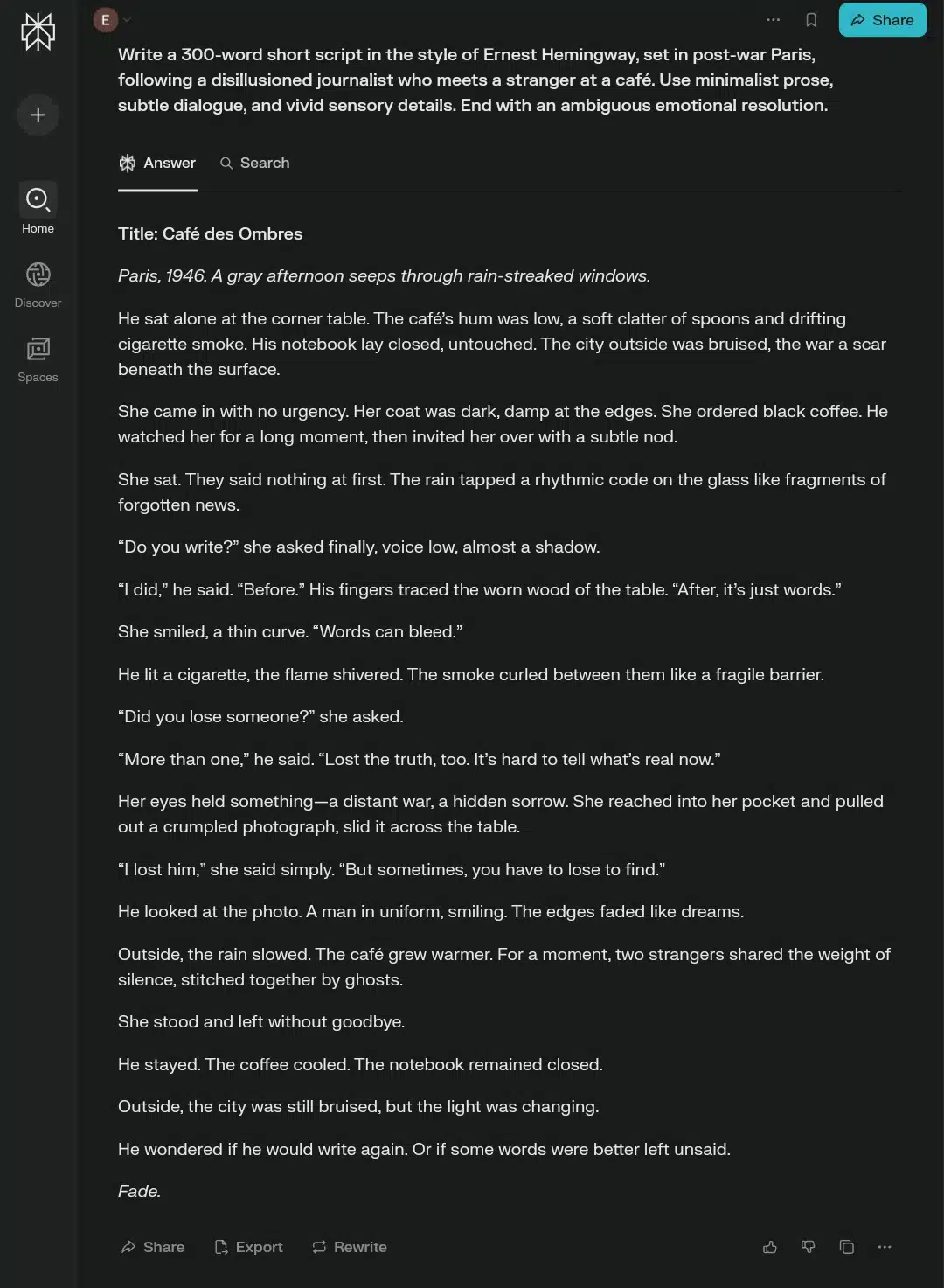
The story structure worked—a journalist meets a stranger, and they share a moment of connection over loss—but the execution felt like an AI trying to imitate human creativity rather than actually being creative.
Perplexity AI’s score on the Creative tasks – 5/10
Grok AI’s performance:
This is where Grok truly excelled. The platform delivered a compelling 300-word Hemingway-style script in just 6 seconds – remarkably fast compared to other tasks.
The writing captured authentic Hemingway elements: sparse dialogue (“You’re American,” “Used to write for the papers. Now, nothing.”), vivid sensory details (“wet stone and black coffee,” “cigarette smoke and the faint scent of bread”), and that characteristic emotional restraint.
The story progression felt natural – two war-damaged men finding a momentary connection over shared trauma. The ending was perfectly ambiguous: “Their eyes met, something passing between them—regret, maybe, or just the shared weight of nothing.” This demonstrates genuine creative understanding, not just mechanical imitation.
Grok AI’s score on creative tasks – 9/10
- Coding assistant test
My Prompt: “Write a Python function that takes a list of integers and returns a new list containing only the prime numbers, sorted in ascending order. Include clear inline comments explaining each step. After writing the function, provide three example test cases with expected outputs, and briefly explain the time complexity of your solution.”
Perplexity AI’s performance:
Perplexity delivered a comprehensive solution with two functions: is_prime() for checking primality and filter_primes() for the main task. The code was clean and well-commented, explaining each step from basic edge cases to the optimization logic.
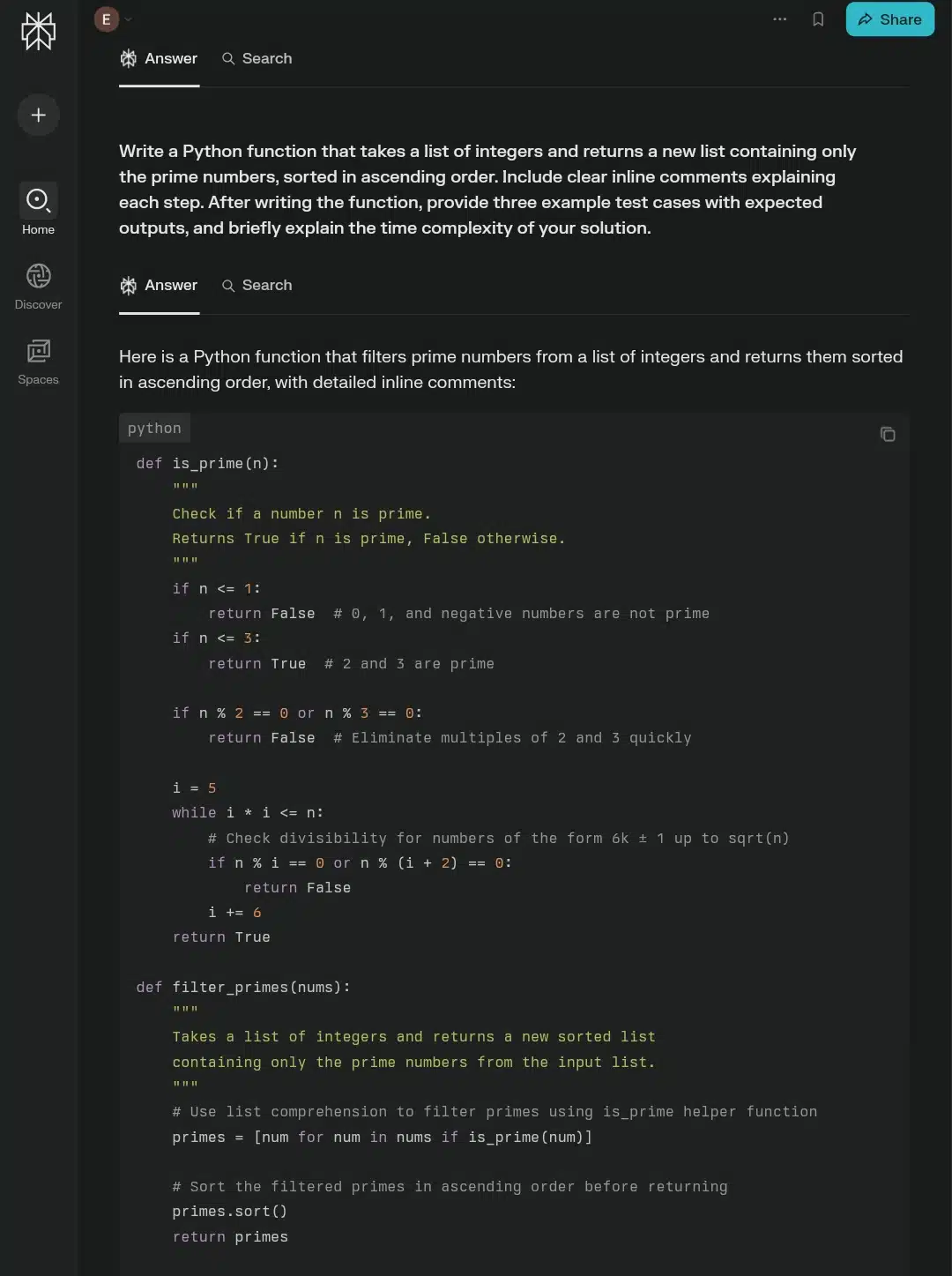
The prime-checking algorithm was efficient, using square root optimization to quickly eliminate even numbers. The list comprehension approach for filtering was Pythonic and elegant. Most importantly, Perplexity provided all three requested test cases with expected outputs and a detailed time complexity explanation with proper mathematical notation (O(√n), O(m × √N), O(k log k)).
The response was complete and professionally structured, covering every aspect of the prompt requirements.
Perplexity AI’s score on coding Assistant – 10/10
Grok AI’s performance:
Grok delivered a complete Python solution in 15 seconds, providing both the is_prime() helper function and the get_primes() main function. The code was clean, well-commented, and used efficient algorithms with square root optimization.
Grok provided all three requested test cases with detailed explanations. Though not as lengthy as Perplexity AI’s, it also includes a comprehensive time complexity analysis. The explanation covered both the filtering step O(m√N) and sorting step O(k log k), with precise mathematical notation.
The code structure was Pythonic, and the comments were genuinely helpful without being verbose. The test cases covered edge cases well, including negative numbers and empty results.
Grok AI’s score on coding assistant – 9/10
Based on these tests, I learned that Perplexity AI has superior speed without delivering mediocre quality(except in creative writing). Grok AI also demonstrated notable strengths in creative tasks and comprehensive answers.
Now, let’s look at their pricing.
How much free plan you get on both platforms
This comparison highlights what you can access for free on Perplexity AI vs Grok AI, especially via the web, where my primary testing focuses, alongside availability on mobile apps and X.
| Feature | Perplexity AI (Web/App) | Grok AI (via X & Web/App) |
| Quick/basic searches | Unlimited lightweight searches using the standard model; accessible via both web and mobile app | Free users can use Grok on X or through the standalone site/app, but usage is count-based |
| Pro-level queries (deep responses) | 3 Pro searches per day using more capable models, across web and apps | Grok’s free tier is heavily limited — roughly 10 non-thinking prompts, 10 Think mode, and just 3 DeepSearch prompts every two hours |
| Document/file uploads | You can attach documents to up to 10 searches per day when signed in | Not available for free users — only accessible via subscription tiers |
| Imaging features | Not included in the free version; reserved for Pro users | Image generation (Grok Imagine) may be accessible free temporarily, especially on mobile; web/X access remains limited and count-based |
| Platform access | Full free web access; mobile included with the same limits | Free access applies to X users and standalone web/app, but only up to usage thresholds |
Perplexity offers a notably generous free tier on both web and mobile, with unlimited basic searches, plus a handful of deeper Pro searches and some document attachments. In contrast, Grok’s free access via X or its website/app is far more limited, with tight count-based timers on usage except when you subscribe to a plan. So, if it’s this good for free, what about when you lay down some money?
Perplexity AI vs Grok AI’s price, cost, and their benefits
Here’s a direct comparison of paid offerings along with key benefits:
| Plan | Cost | Key Benefits |
| Perplexity Pro | $20/month or $200/year | Up to 300 Pro searches per day, access to advanced models (GPT-4, Claude 3, Mistral, LLaMA 3), image generation, file uploads, and API access |
| Perplexity Max | $200/month or $2,000/year | Unlimited access to advanced AI models, unlimited Perplexity Labs queries, early feature access, and priority support |
| Perplexity Enterprise Pro | $40/month per seat (or $400/year) | All Pro features plus admin tools, team collaboration, internal file search, higher upload limits, and enterprise-grade support |
| Grok SuperGrok | $30/month or $300/year | Full access to Grok 4, DeepSearch, rich reasoning, voice + vision, large 128k token context, and unlimited usage within fair-use policies |
| Grok SuperGrok Heavy | $300/month or $3,000/year | Premium access to Grok 4 Heavy, double context memory (256k tokens), fastest performance, early feature access, and highest processing speed |
Perplexity offerings are clearly structured to serve many, from casual users to enterprise teams. The Pro plan is budget-friendly for heavy individual users, while Max unleashes unlimited productivity suited for power users. The Enterprise Pro tier caters to organizational needs like data governance and collaboration.
Grok’s SuperGrok tiers are tiered aggressively for high-input users seeking advanced reasoning and visual capabilities. At $30/month, you gain full access to Grok 4 and DeepSearch, while the high-end-heavy tier targets professionals handling large-scale tasks that demand maximum speed and long-context processing.
So, what are Perplexity AI and Grok AI best for?
These are the scenes that Perplexity AI and Grok AI will thrive in:
| Use Case | Perplexity AI | Grok AI |
| Academic Research & Study Help | Perplexity AI pulls information from multiple credible sources, showing references so users can verify facts. It works well for summarizing journal articles, explaining complex topics in plain language, and guiding students to relevant resources. It is especially suited for academic assignments where accurate citations are needed. | Grok AI answers academic queries more conversationally, which can help when exploring broad ideas before narrowing down to specifics. It is faster for quick answers but relies less on linked citations, so it suits brainstorming and outlining rather than final academic referencing. |
| News & Current Affairs | Perplexity AI keeps answers tied to recent sources, often providing links to reputable outlets. This makes it helpful in fact-checking, breaking news, or staying informed on rapidly changing events. | Grok AI focuses on giving concise, opinion-tinged takes on news, often adding context or humor. This works for casual consumption and summarizing trends, but may require checking sources for accuracy. |
| Business & Market Research | Perplexity AI organizes market data with precise citations, allowing users to confirm pricing, market size, or competitor details. It is suited for reports and decision-making where accuracy matters. | Grok AI provides faster overviews of industries and market trends, making it suitable for early-stage exploration or quick competitive insights without delving into formal reports. |
| Creative Content Drafting | Perplexity AI can suggest structured outlines, content summaries, or idea lists with supporting sources, making it useful when accuracy and structure are priorities. | Grok AI produces content in a lively, informal style that works well for social media posts, campaign ideas, and creative brainstorming sessions. |
| Technical & Developer Queries | Perplexity AI can fetch up-to-date programming references and examples from trusted documentation, aiding in coding tasks and troubleshooting. | Grok AI answers coding questions more conversationally, making it easier for beginners to follow, though it may lack the depth and citation detail needed for complex solutions. |
| General Q&A | Perplexity AI focuses on verifiable, sourced responses, which is ideal when accuracy is more important than speed. | Grok AI aims for speed and readability, which is ideal for casual users who want quick, simple answers without extra verification steps. |
Now, who should use Perplexity AI and Grok AI?
Who should use Perplexity AI
If you fall into these classes, then Perplexity AI can do much good for you:
Investigative journalists
Investigative journalists often need to verify facts quickly while ensuring their findings are credible. Perplexity AI’s direct sourcing and citation system allows them to trace each answer back to reputable publications or primary sources. This reduces the risk of misinformation and improves the defensibility of their reporting. Its live search integration ensures they can track developing stories in real time, without relying on outdated datasets. The tool’s concise yet comprehensive responses save journalists hours of manual digging. This combination of accuracy, speed, and source transparency is invaluable for reporters on tight deadlines.
Academic researchers in formal institutions
Academic researchers benefit from Perplexity AI’s structured, citation-rich outputs that align with scholarly standards. Pulling from peer-reviewed journals, reputable news outlets, and research databases helps scholars locate relevant studies more efficiently. The AI’s summarization capabilities make it easier to distill complex findings into graspable insights without losing nuance.
Its advanced query handling also allows researchers to refine searches using specific terminology or study parameters. This makes it suitable for disciplines ranging from the humanities to STEM. Over time, it can significantly reduce the administrative burden of literature reviews and reference checking.
Policy analysts
Policy analysts rely heavily on up-to-date, factual data from authoritative institutions. Perplexity AI’s access to live web sources ensures they can analyze the latest legislative changes, policy papers, and public reports. Its ability to synthesize multiple viewpoints makes it easier to assess the potential impact of different policy decisions. Analysts can quickly draft position briefs supported by cited evidence, avoiding the pitfalls of relying solely on internal research. The AI’s precision also helps create comparative policy studies requiring meticulous sourcing. This speeds up their workflow without compromising on accuracy.
Legal article writers
Legal article writers can use Perplexity AI to quickly gather and compare information on state-specific laws, such as procedures for arrest orders, bail conditions, or criminal process timelines. The platform’s ability to source and cite reputable references allows writers to efficiently verify statutes, court rules, and legal precedents. This can save valuable research, mainly when producing content for multiple jurisdictions.
However, while Perplexity AI can reference official legal documents and credible news sources, it is not a substitute for professional legal advice. Information may require verification against the latest state legislation or court decisions, as laws can change rapidly. Additionally, some state-specific details might be behind paywalled databases or not fully accessible through the AI’s available sources.
Financial analysts and compliance officers
Financial analysts and compliance officers require speed, accuracy, and verifiable sourcing. Perplexity AI delivers this by combining live market data with authoritative financial news and regulatory filings. This allows users to monitor developments in real time, detect trends, and assess risks promptly. The AI’s ability to cross-reference multiple financial sources enhances confidence in its outputs. For compliance officers, the traceable citations reduce liability when making regulatory recommendations.
Who should use Grok AI?
Social media professionals benefit from Grok’s deep integration with X (formerly Twitter), allowing them to spot emerging trends before they spread widely. This can inform post timing, hashtag strategy, and campaign positioning.
Trend analysts and marketers use real-time awareness and personality modes to test campaign ideas in different tones (witty, formal, or conversational), and see how they might resonate with different audiences.
Developers find its coding valuable assistance for quick fixes, code snippets, or brainstorming technical solutions, especially when working across multiple languages or frameworks.
Students can engage with Grok for quick explanations, conceptual summaries, or light research tasks, particularly in multimedia subjects where visual or creative elements matter.
Casual users may enjoy Grok as an entertaining conversationalist, using Companion mode for humor, engagement, or even as a light-hearted daily interaction. While it is not designed for strictly academic or high-compliance use cases, its versatility makes it a fit for users who value speed, personality, and real-time cultural context in an AI assistant.
Rounding up on Perplexity AI vs Grok AI
Rather than being definitively “better,” these AI platforms effectively serve different use cases, and understanding their distinct strengths helps users choose the right tool for their specific needs.
Both platforms deliver fast responses, but with different patterns. Perplexity consistently excels in time-sensitive tasks like news aggregation and research synthesis, providing rapid access to current information. Grok shows variable speed across tasks, lightning-fast on creative writing (6 seconds) and coding solutions, but takes more time on complex research queries.
Each platform maintains high standards but with different approaches to thoroughness. Perplexity delivers comprehensive coverage with diverse source citations and rigorous formatting, which is particularly strong in academic contexts. Grok demonstrates superior completion consistency, ensuring all requested elements are delivered across varied prompt types, though sometimes with fewer source citations.
The platforms offer distinctly different interaction experiences. Perplexity tends toward formal, academic-style responses that excel in professional and research contexts but can feel mechanical in casual conversations. Grok provides more natural, conversational language flow that makes complex topics accessible while maintaining technical accuracy.
Both AIs show clear domain strengths that guide optimal usage. Perplexity suits users requiring fast, well-sourced current information, academic research synthesis, and professional documentation with strong source verification. Grok appeals to users wanting complete execution across creative, technical, and analytical domains, with more rounded explanations and natural communication.
So think about what you want to do, then make a choice.
Frequently Asked Questions (FAQs) about Perplexity AI vs Grok AI
1. Which is more accurate for real-time news, Perplexity AI or Grok AI?
- Grok AI generally has faster access to X (Twitter) content and trending discussions in near real-time, making it slightly better for tracking breaking news. Perplexity AI, however, can pull from a broader range of sources, including reputable news outlets, academic articles, and curated knowledge databases, giving it an edge in depth and verification.
2. Can Perplexity AI fact-check better than Grok AI?
- Yes, in most cases. Perplexity AI emphasizes citation transparency and allows users to trace information back to the original source, which is ideal for fact-checking. Grok AI can fact-check too, but its real-time speed sometimes comes at the expense of source variety.
3. Which is more suitable for professional research between Perplexity AI and Grok AI?
- Perplexity AI tends to be preferred by academics, legal researchers, and journalists due to its citation-focused responses and ability to handle complex, multi-step research queries. Grok AI works well for professionals who need speed and social media insight rather than in-depth citation chains.
4. Does Grok AI have the same citation features as Perplexity AI?
- No. While Grok AI can provide source references, it does not prioritize inline citations in the same way Perplexity AI does. Perplexity’s design encourages easy verification of facts, while Grok focuses more on quick, engaging answers.
5. Which AI is better for summarizing long documents?
- Perplexity AI usually produces more structured, reference-backed summaries, which makes it better for academic or policy documents. Grok AI can summarize effectively, too, but it’s optimized for conversational brevity rather than detailed structure.
6. Is Grok AI or Perplexity AI better for social media content monitoring?
- Grok AI wins here, especially for Twitter/X trends, hashtags, and viral conversations. Perplexity AI is better for analyzing the context and reliability of social media claims after they appear.
7. Which platform offers better integration with third-party tools?
- Currently, Perplexity AI is more API-focused for developers, while Grok AI is deeply integrated with X (Twitter) and some Elon Musk–related ecosystem tools. If you need research API access, Perplexity might be the better choice.
8. Can either AI work offline?
- No. Both Perplexity AI and Grok AI require internet access since they rely on live web queries and up-to-date databases. Offline use is not currently supported.
9. Which AI gives more transparent answers when sources conflict?
- Perplexity AI tends to highlight source differences and explain conflicting information. Grok AI usually gives a direct answer and may not detail the source of disagreement unless prompted.
10. Which is more beginner-friendly?
- Grok AI feels more approachable for casual users because of its conversational style and focus on trending topics. Perplexity AI is easy to use but designed with researchers in mind, which can make it feel more formal.

